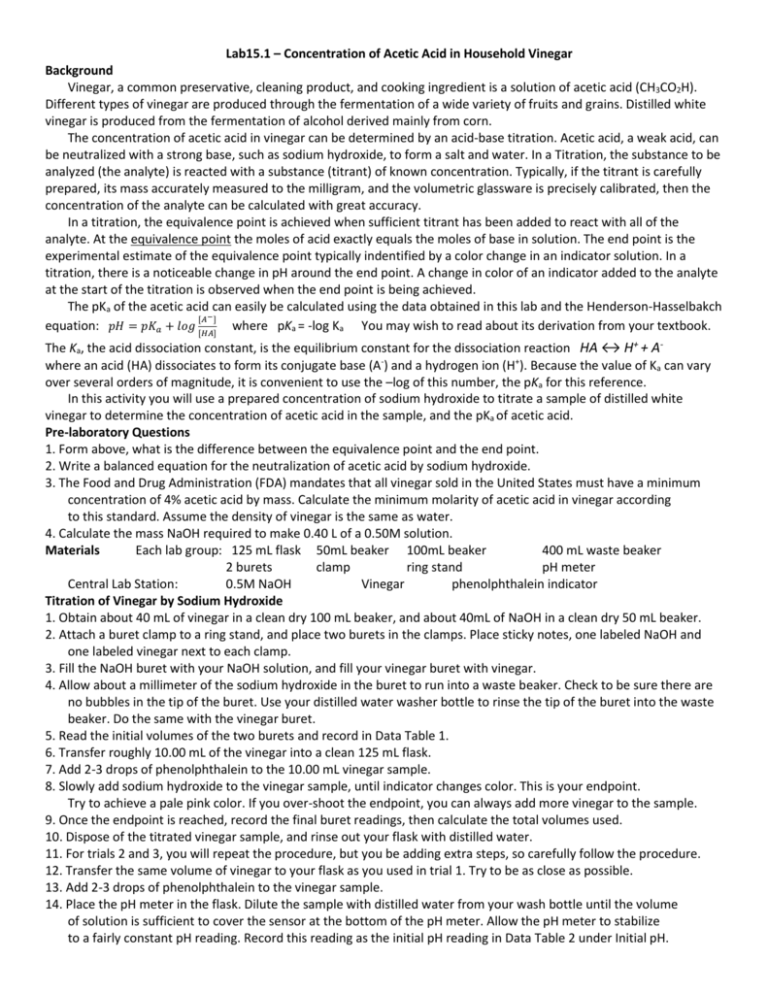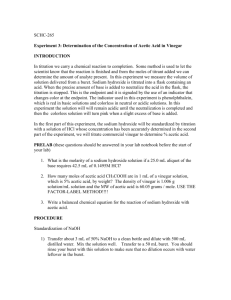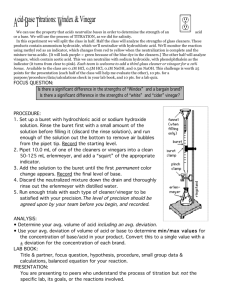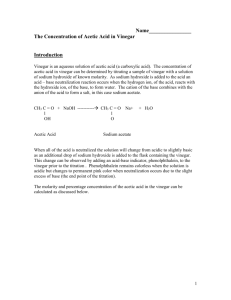Lab15.1 pH of Household Vinegar.doc
advertisement

Lab15.1 – Concentration of Acetic Acid in Household Vinegar Background Vinegar, a common preservative, cleaning product, and cooking ingredient is a solution of acetic acid (CH3CO2H). Different types of vinegar are produced through the fermentation of a wide variety of fruits and grains. Distilled white vinegar is produced from the fermentation of alcohol derived mainly from corn. The concentration of acetic acid in vinegar can be determined by an acid-base titration. Acetic acid, a weak acid, can be neutralized with a strong base, such as sodium hydroxide, to form a salt and water. In a Titration, the substance to be analyzed (the analyte) is reacted with a substance (titrant) of known concentration. Typically, if the titrant is carefully prepared, its mass accurately measured to the milligram, and the volumetric glassware is precisely calibrated, then the concentration of the analyte can be calculated with great accuracy. In a titration, the equivalence point is achieved when sufficient titrant has been added to react with all of the analyte. At the equivalence point the moles of acid exactly equals the moles of base in solution. The end point is the experimental estimate of the equivalence point typically indentified by a color change in an indicator solution. In a titration, there is a noticeable change in pH around the end point. A change in color of an indicator added to the analyte at the start of the titration is observed when the end point is being achieved. The pKa of the acetic acid can easily be calculated using the data obtained in this lab and the Henderson-Hasselbakch [𝐴−] equation: 𝑝𝐻 = 𝑝𝐾𝑎 + 𝑙𝑜𝑔 [𝐻𝐴] where pKa = -log Ka You may wish to read about its derivation from your textbook. The Ka, the acid dissociation constant, is the equilibrium constant for the dissociation reaction HA ↔ H+ + Awhere an acid (HA) dissociates to form its conjugate base (A-) and a hydrogen ion (H+). Because the value of Ka can vary over several orders of magnitude, it is convenient to use the –log of this number, the pKa for this reference. In this activity you will use a prepared concentration of sodium hydroxide to titrate a sample of distilled white vinegar to determine the concentration of acetic acid in the sample, and the pKa of acetic acid. Pre-laboratory Questions 1. Form above, what is the difference between the equivalence point and the end point. 2. Write a balanced equation for the neutralization of acetic acid by sodium hydroxide. 3. The Food and Drug Administration (FDA) mandates that all vinegar sold in the United States must have a minimum concentration of 4% acetic acid by mass. Calculate the minimum molarity of acetic acid in vinegar according to this standard. Assume the density of vinegar is the same as water. 4. Calculate the mass NaOH required to make 0.40 L of a 0.50M solution. Materials Each lab group: 125 mL flask 50mL beaker 100mL beaker 400 mL waste beaker 2 burets clamp ring stand pH meter Central Lab Station: 0.5M NaOH Vinegar phenolphthalein indicator Titration of Vinegar by Sodium Hydroxide 1. Obtain about 40 mL of vinegar in a clean dry 100 mL beaker, and about 40mL of NaOH in a clean dry 50 mL beaker. 2. Attach a buret clamp to a ring stand, and place two burets in the clamps. Place sticky notes, one labeled NaOH and one labeled vinegar next to each clamp. 3. Fill the NaOH buret with your NaOH solution, and fill your vinegar buret with vinegar. 4. Allow about a millimeter of the sodium hydroxide in the buret to run into a waste beaker. Check to be sure there are no bubbles in the tip of the buret. Use your distilled water washer bottle to rinse the tip of the buret into the waste beaker. Do the same with the vinegar buret. 5. Read the initial volumes of the two burets and record in Data Table 1. 6. Transfer roughly 10.00 mL of the vinegar into a clean 125 mL flask. 7. Add 2-3 drops of phenolphthalein to the 10.00 mL vinegar sample. 8. Slowly add sodium hydroxide to the vinegar sample, until indicator changes color. This is your endpoint. Try to achieve a pale pink color. If you over-shoot the endpoint, you can always add more vinegar to the sample. 9. Once the endpoint is reached, record the final buret readings, then calculate the total volumes used. 10. Dispose of the titrated vinegar sample, and rinse out your flask with distilled water. 11. For trials 2 and 3, you will repeat the procedure, but you be adding extra steps, so carefully follow the procedure. 12. Transfer the same volume of vinegar to your flask as you used in trial 1. Try to be as close as possible. 13. Add 2-3 drops of phenolphthalein to the vinegar sample. 14. Place the pH meter in the flask. Dilute the sample with distilled water from your wash bottle until the volume of solution is sufficient to cover the sensor at the bottom of the pH meter. Allow the pH meter to stabilize to a fairly constant pH reading. Record this reading as the initial pH reading in Data Table 2 under Initial pH. Remove the pH meter during titration. 15. Titrate exactly half the volume of NaOH as used in trial 1. This is referred to as the midpoint of titration. Half of the [H+] has been reacted with the [OH-]. 16. Place the pH meter in the flask. Allow the pH meter to stabilize to a fairly constant pH reading. Record the pH and total volumes in Data Table 2 as the midpoint reading for Trial 2. 17. Titrate your sample to the endpoint as you did with the first sample. Record the pH and total volumes at the endpoint as the final readings under Trial 2. 18. Repeat steps 12 – 17 for Trial 3. Then clean all glassware, return all lab equipment, and dispose of chemicals. Data Table 1 Initial Buret Reading (ml) Final Buret Reading (ml) Volume Used Vinegar 0.5M NaOH Data Table 2 Trial 2 Trial 3 Initial pH Volumes Used at Midpoint (ml) Midpoint pH Volumes Used at Endpoint (ml) Endpoint pH Vinegar 0.5M NaOH Vinegar 0.5M NaOH Calculations 1. Use your experimental data to calculate the concentration of acetic acid in your vinegar sample. Show your work. Average calculated molarity of acetic acid: ____________M 2. Calculate the pKa of acetic acid on the basis of your experimental data from the midpoint of the titrations of samples 2 and 3 using the Henderson-Hasselbalch equation: [𝐴− ] 𝑝𝐻 = 𝑝𝐾𝑎 + 𝑙𝑜𝑔 [𝐻𝐴] Show your work. You may want to read the background section in the lab, and refer to your text for the derivation of this equation. Average value of pKa of acetic acid, based on your experimental data: ____________ 3. The accepted pKa of acetic acid is 4.792. Find the percent error for pKa of acetic acid. Show your work. Laboratory Questions 1. Why was it necessary to measure precisely the volume of the analyte added to the flask and the volume of titrant consumed, but not necessary to note the exact volume of water added from the wash bottle for dilution of the sample or for the washing of the buret and flask during the titrations? Lab15.1 – Concentration of Acetic Acid in Household Vinegar Name _______________ Objectives: Procedure: Pre-laboratory Questions 1. Form above, what is the difference between the equivalence point and the end point. 2. Write a balanced equation for the neutralization of acetic acid by sodium hydroxide. 3. The Food and Drug Administration (FDA) mandates that all vinegar sold in the United States must have a minimum concentration of 4% acetic acid by mass. Calculate the minimum molarity of acetic acid in vinegar according to this standard. Assume the density of vinegar is the same as water. 4. Calculate the mass NaOH required to make 0.40 L of a 0.50M solution. Data Table 1 Initial Buret Reading (ml) Final Buret Reading (ml) Volume Used Vinegar 0.5M NaOH Data Table 2 Trial 2 Trial 3 Initial pH Volumes Used at Midpoint (ml) Midpoint pH Volumes Used at Endpoint (ml) Endpoint pH Vinegar 0.5M NaOH Vinegar 0.5M NaOH Calculations 1. Use your experimental data to calculate the concentration of acetic acid in your vinegar sample. Show your work. Average calculated molarity of acetic acid: ____________M 2. Calculate the pKa of acetic acid on the basis of your experimental data from the midpoint of the titrations of samples 2 and 3 using the Henderson-Hasselbalch equation: [𝐴− ] 𝑝𝐻 = 𝑝𝐾𝑎 + 𝑙𝑜𝑔 [𝐻𝐴] Show your work. You may want to read the background section in the lab, and refer to your text for the derivation of this equation. Average value of pKa of acetic acid, based on your experimental data: ____________ 3. The accepted pKa of acetic acid is 4.792. Find the percent error for pKa of acetic acid. Show your work. Laboratory Questions 1. Why was it necessary to measure precisely the volume of the analyte added to the flask and the volume of titrant consumed, but not necessary to note the exact volume of water added from the wash bottle for dilution of the sample or for the washing of the buret and flask during the titrations?






